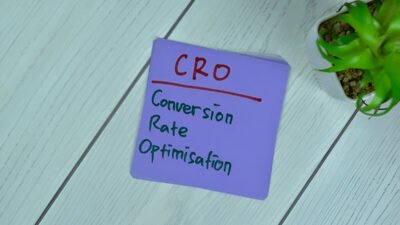No matter how much traffic your site draws, its success finally turns on the response by way of conversion. Whether you want to sell products, cultivate leads or drive app signups, converting visitors into action-takers is at the core of your business aims. This is where conversion rate optimization (CRO) comes in.
This blog examines the need for CRO, how it affects your business growth, and reasons businesses must not ignore it in today’s digitally competitive world.
What is Conversion Rate Optimization (CRO)?
Before we dive into the importance of CRO, we need to understand what it is.
Conversion rate optimization refers to the process of improving your website or digital platforms to get more visitors to take specific actions that you want. These actions can range from purchasing a product, filling out a contact form or signing up for your newsletter.
Basically, it’s about better utilizing the traffic that your website already receives, converting more of your audience into customers or engaged users.
Why Conversion Rates Matter
Your website’s conversion rate is a critical gauge. It is simply calculated:
For example, suppose 1000 visitors come to your website and 25 of them purchase something. Your conversion rate is 2.5%. Optimizing that rate—specifically increasing it from 3 or 4 percent—can bring substantial revenue growth without extra spending to add stores worth added traffic.
The Key Benefits of Conversion Rate Optimization
1. Maximum ROI for Existing Traffic
One of the advantages of CRO on the biggest is to truly maximize the traffic you’ve already got. No matter whether you’re running ads, investing in content marketing, or managing SEO, acquiring traffic for a site is expensive. As a result, CRO can provide a much more immediate return on that investment, meaning you are able to convert many of the website visitors paid for and hard-won into customers or lead contacts.
Take the following example: Suppose that improved page design and one more call to action button can double your sales. In that case it’s like doubling the income from your present level of traffic without any additional marketing expenses.
2. Improves User Experience
Real CRO isn’t at all about the latest “growth hacks” you read on the blog that are supposed to entice users into action by questionable means. Instead, it tries to grasp how people think and what they need.
CRO frequently identifies places–for instance, on your website and in its navigation, or particularly in pages dealing with transactions–where visitors are likely to become angry or uncooperative. By addressing these points of pain, you not only get more conversions but also higher overall user satisfaction, which makes people more likely to return.
3. Drives Sustainable Business Growth
Paid ad portfolios and convergence funnels: the first has limits that it can’t exceed the second hits point of diminishing returns before too long. By contrast, CRO offers sustainable growth: it just means constantly improving your website’s performance. A higher conversion rate means every new visitor brings more and more value to your business, thus creating an escalating base for future revenue generation.
Businesses emphasizing CRO often have the ability to respond more quickly than those only targeting traffic of all kinds. They adapt much quicker both to changes in the market and customer behavior.
4. Creates Richer Customer Insights
By testing and analyzing, website conversion gives unique insights into what your customers like and how they behave. Does urgency prompt them to buy more readily, such as pointing out that only so many days remain for something at all now (like with a countdown timer)? Or does a simple, uncluttered design (anything else compared to other sites in your field) generate interest and clicks?
It goes beyond your website: such learnings can impact overall branding, marketing campaigns, product design and sales strategies alike—so as one unified whole bring more effective customer experiences to bear widely throughout all activities within the company.
5. Gets You Ahead Of the Competition
The digital space gets more crowded every day. Regardless of industry, your target audience is besieged by offerings from competing brands. As such, concentrating on CRO allows you to make your business stand out by offering unique and fluid experiences which transcend competitors’ offerings.
Even minor adjustments for example changing copy on a CTA or inserting displays with real consumer reviews impact directly upon people’s purchasing decisions. And they help you win untapped markets of prospective clients.
6. Lower Customer Acquisition Cost
It is expensive to attract new business – according to HubSpot, the cost of acquiring a customer has gone up almost 50% in the last five years. CRO helps to offset these rising costs by getting better yield out from your current traffic, making acquisition of customers cheaper.
Instead of raising ad spend in order to increase revenue, you can work smarter by converting more of the traffic for which you are already paying.
How CRO Works in Real Life
1. Analyzing User Behavior
Tools such as Google Analytics, Hotjar and Crazy Egg can find where users click on your site, where they fall off and which pages are not performing well. Such data analysis provides opportunities for improvement.
2. Doing A/B Tests
A/B testing is an important principle of CRO. By varying versions of a page or an item (such as the headline and button color in particular), you get statistics on what communicates most to your visitors.
For example:
- Is a red “Buy Now” button more effective than a green one?
- If there is a testimonial under the product description, are more potential buyer willing to trust and the conversion rate higher?
3. Simplifying Your Website
Complications kill conversions. CRO focuses on eliminating roadblocks and simplifying the user experience—from reducing the steps required to check out to making your website mobile-friendly.
4. Creating Clear Calls-to-Action (CTAs)
Your site’s CTAs guide users toward their next step. Whether you are asking them to “Sign Up for Free” or “Shop Now,” CRO ensures your call-to-action stands out and drives action.
5. Personalizing the Experience
Dynamic, personalized content is becoming the gold standard for CRO. A first-time visitor may see a welcome offer, while a returning user might see a tailored product recommendation based on their browsing history.
An Example of CRO’s Impact in the Real World
Case Study: E-commerce Success
A mid-sized e-commerce brand selling athletic wear implemented a CRO strategy focused on their checkout process. Before optimization, the company was losing 65% of customers in the checkout stage.
After analyzing customer drop-offs, they:
- Removed unnecessary information fields.
- Added multiple payment options.
- Highlighted free shipping at checkout.
The result? A 30% boost in their overall conversion rate.
This single focus on improving one feature generated an enormous increase in revenue while leaving their existing traffic pattern unchanged.
Actions to Begin Improving Your Conversion Rate ROI
If your business is to prosper in a digital-first world, CRO is no longer a “nice-to-have”—it’s an imperative. Here’s how you can get started today:
- Audit your website with heatmaps and analytics tools.
- Identify and prioritize underperforming pages for optimization.
- Focus on gradual, incremental changes with A/B testing.
- Pay attention to visitor feedback and pain points.
- To enhance strategy, you can partner with a CRO professional or get CRO tools directly.
When you optimize your conversions, it’s not that you’re simply improving the website; you are setting your whole business up for scalable success.





